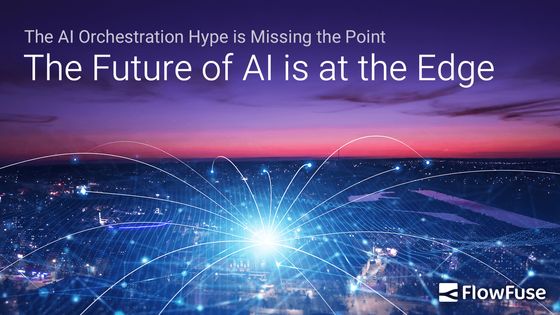Beyond Cloud AI Orchestration: Why the Future is Hybrid Edge-Cloud Intelligence
While cloud orchestration excels in digital workflows, the industrial world needs a hybrid approach.

Congratulations to n8n on their Series C funding round! This is a fantastic milestone and a clear signal that the market has moved beyond AI experimentation and into the serious business of production deployment. Platforms like n8n are mastering what we call centralized orchestration: creating cloud-native "brains" that connect digital services, APIs, and data sources to execute complex workflows. This approach excels for digital-first applications and represents a crucial evolution in workflow automation.
But for industrial applications, we need to think beyond traditional cloud orchestration.
The tech world is buzzing with talk of AI agents and orchestration platforms, and the energy around n8n's recent funding is proof of this momentum. This energy is a fantastic sign of a maturing market, proving that we've moved beyond AI experimentation and into the serious business of production deployment.
Cloud orchestration platforms excel at what they're designed for: connecting digital services, managing API workflows, and orchestrating cloud-native applications. However, for the industries that power our physical world—manufacturing, logistics, energy, and infrastructure—we need complementary approaches that address the unique requirements of operational technology. This is where hybrid edge-cloud architectures become essential.
Industrial Requirements: Where Cloud-Only Solutions Face Challenges
When operations involve real-world assets like factory machinery, remote sensors, or logistics fleets, purely centralized approaches encounter specific industrial constraints. For applications where milliseconds matter—such as emergency shutdowns or quality control decisions—the latency of cloud round-trips can be too slow for critical responses. Connectivity challenges in industrial environments, from remote oil platforms to underground mining operations, require systems that can operate intelligently even when cloud connections are intermittent.
Additionally, the economics of data movement become significant at industrial scale. Streaming continuous data from thousands of sensors to the cloud for processing can be costly and inefficient, especially when much of that processing could happen locally. Many industries also have regulatory requirements that mandate certain operational data remain on-premise for compliance and security reasons.
These constraints don't invalidate cloud orchestration—they highlight the need for hybrid approaches that leverage both cloud capabilities and edge intelligence where each excels.
The Next Paradigm: Hybrid Edge-Cloud Intelligence
The future of industrial AI isn't choosing between cloud or edge—it's intelligently combining both. Rather than replacing cloud orchestration, the industrial world needs a hybrid architecture: a distributed nervous system where cloud orchestration handles high-level coordination and data aggregation, while edge intelligence manages real-time operations and local decision-making.
In this paradigm, AI operates at multiple levels. Edge devices handle immediate responses—predictive maintenance alerts, quality control decisions, and safety shutdowns—without waiting for cloud communication. Meanwhile, cloud orchestration excels at what it does best: aggregating data from multiple sites, running complex analytics, coordinating across systems, and managing enterprise-wide workflows. This creates a complementary relationship where each layer operates within its strengths.
FlowFuse: Bridging Edge and Cloud Intelligence
While the market builds excellent tools for cloud-based AI orchestration, FlowFuse specializes in the hybrid approach that industrial applications demand. Built on the proven foundation of Node-RED, our platform provides engineers with a unified control tower to manage both cloud orchestration and edge intelligence at scale.
FlowFuse Cloud enables centralized management and coordination, while our edge capabilities allow thousands of Node-RED instances to operate intelligently at remote locations. This hybrid architecture lets you seamlessly integrate the physical and digital worlds—leveraging cloud orchestration for enterprise workflows while maintaining real-time edge intelligence where it matters most.
Our FlowFuse AI Assistant simplifies the creation and management of complex logic across both cloud and edge environments, democratizing advanced automation without requiring specialized data science skills. Soon, with our upcoming AI Agent nodes, FlowFuse will enable powerful AI agents to operate seamlessly across the entire hybrid architecture, from cloud coordination to edge execution.
Conclusion: The Power of Hybrid Intelligence
The rise of AI orchestration platforms represents an important evolution in automation technology. These tools excel in their domain and will continue to play a crucial role in digital transformation initiatives.
For industrial applications, the future lies in hybrid architectures that combine the strengths of both approaches. Cloud orchestration provides the coordination, analytics, and enterprise integration capabilities that modern businesses require, while edge intelligence delivers the real-time responsiveness and resilience that industrial operations demand.
Choosing the right approach comes down to understanding your requirements. For digital-first applications, cloud orchestration platforms offer powerful solutions. For industrial and IoT applications that bridge physical and digital worlds, hybrid edge-cloud architectures provide the comprehensive intelligence needed to succeed.
Ready to Build the Future of Industrial AI?
FlowFuse is built for the challenges of industrial and IoT data. Whether you're implementing Industry 4.0 initiatives or building predictive maintenance systems, we provide the platform to deploy and manage intelligence across both cloud and edge environments.
About the Author
Pablo Filomeno
Product Marketing Manager
Pablo is the Product Marketing Manager of FlowFuse. With a background in strategic communications and a passion for making complex technologies accessible, his mission is to help industrial and software teams discover the power of FlowFuse to transform their operations.
Related Articles:
- FlowFuse + LLM + MCP = Text Driven Operations
- The Industrial IoT Market Shift: What the PTC Divestment Means for Your Data Strategy
- MCP and Custom AI Models on FlowFuse!
- EtherNet/IP Integration with FlowFuse: Communicating with Allen-Bradley PLCs
- The Node-RED Revolution: How Low-Code is Democratizing Industrial Automation